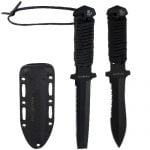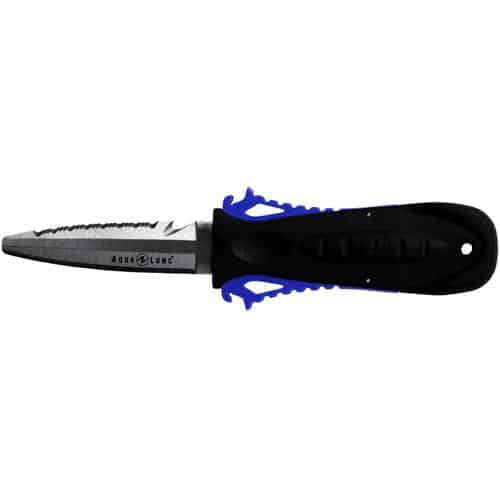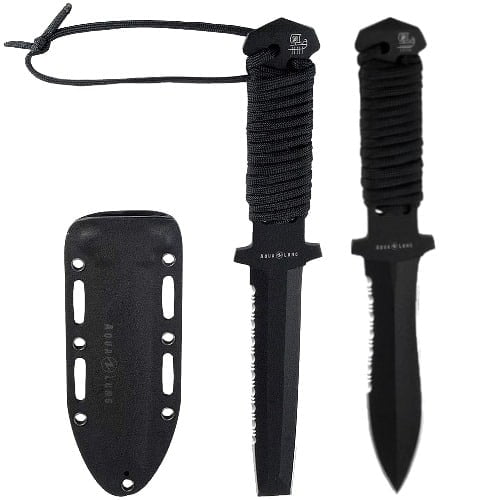A Dive Knife can easily be overlooked as a necessary piece of dive equipment, but having one can make your diving much easier, safer, and fun.
Your dive knives can be a handy tool underwater and can be used to cut yourself or trapped animals from entanglement or used to bang on your tank to get your buddy’s attention.
Either way, there is no one best dive knife when it comes to making your choice. You want a dive knife that is sharp, strong, and resistant to corrosion. You will want to consider the blade material, how you will mount it, and whether or not it’s versatile enough for your diving needs.
A good dive knife is the best tool you can have as a diver -- it can save your life. A sharp knife can help cut you out of any entanglement.
What Are The Best Dive Knives?
One of the most important features of a dive knife is its ability to resist corrosion caused by saltwater. For this reason, most dive knives are made from either Titanium or Stainless Steel, each has its own characteristics.
Therefore we have separated our reviews into both these categories for easy sorting. If you would like to find out the pro and cons of each and which will work best for you, continue reading the buying guide below.
You want a dive knife that is sharp, strong, and resistant to corrosion
Best Dive Knives For 2024 - Comparison Chart
This is a hard list to create since each of these knives has its own specific features and use. Below you'll find our pick of the best dive knives available today. Use the chart to quickly compare features and find a knife that works best for you. .
Image | Knife Name | We Liked | Best Price |
|---|---|---|---|
 | Available in sharp and blunt tips Handle rapped in 5mm paracord Made from a single piece of Titanium | ||
 | Affordably Priced for a Titanium Knife Compact Folding Design Serrated edge with line cutter | ||
 | Secure locking mechanism Rust-resistant 304 Stainless Steel Variable mounting option | ||
 | Functions as both Knife and Scissors Straight Blade, Serrated edge, line cutting notch Ergonomic handle grip | ||
 | Straight and serrated edge Corrosion-resistant blade ergonomic grip | ||
 | Designed for heavy-duty use Stainless steel with black coating Straight/serrated edge with line cutter |
Your dive knife is not a weapon. You should never use it to deface the underwater environment or harm aquatic animals.
Best Stainless Steel Dive Knives
While stainless steel is great at resisting corrosion, it does still include a trace amount of iron and will rust. There they will require some maintenance after diving.
Aqua Lung Squeeze Lock Knife

View More Knives by Aqua Lung
I have already both two squeeze lock knife and love both of them. The squeeze lock system is very secure but still easily release the knife when needed. I also like that there is different attachment options too.
Specification:
Blade Length | 3" |
Handle Length | 3.5" |
View Product on Recommended Retailers Site:
What We Like
What We Don't Like
SUMMARY
The Aqua Lung Squeeze Lock dive knife blade is constructed from 304 stainless steel for rust-resistance and added durability. Featuring a double edge blade with one side being straight and the other serrated, a blunt tip, and a line cutter notch, it’s very versatile and can cut through a variety of different materials.
The patented Squeeze Lock design secures the knife in its sheath while being easy to release with a squeeze of the handle.
There are also variable mounting options. You can easily mount the knife to a BCD, Scuba Regulator hose, or use the locking belt clip to secure the sheath to the webbing. There is also the option for a leg mount, but the straps must be purchased separately.
This knife is a great choice if you want a solid dive knife that will mount anywhere.
Cressi Alligator - Scissor/Knife

View More Knives by Cressi
The is a must have tool for any diver...I have it mounted on my BCD inflator hose and it works great. It easily lock and unlocks from the sheath using on hand, and it stays lock even with heavy moments. I think this is a tool every serious diver should have.
Specification:
Blade Length | 3.15" |
Handle Length | 3.35" |
View Product on Recommended Retailers Site:
What We Like
What We Don't Like
SUMMARY
The Cressi Alligator Scissor/Knife is very versatile, offering two functions in one tool. The scissors work great when cutting line and fishing nets and the knife can be used for cutting stronger materials like ropes.
The knife still has all the features of a traditional dive knife with the stainless steel blade equipped with both a straight and serrated edge, as well as a line cutter notch.
This knife is a great choice if you want the versatility of a dive knife and the utility of scissors in one single tool.
Cressi Giant Knife

View More Knives by Cressi
It cuts through Lionfish like butter! The knife itself and it’s holster are perfect, however, the holater straps require you to cut your own holes for the buckles to fit into (which is surprisingly difficult). Once the straps are sized appropriately to your body, you will have no other troubles from this knife. Invasive species beware!
Specification:
Blade Length | 7.01" |
Handle Length | 4.81" |
View Product on Recommended Retailers Site:
What We Like
What We Don't Like
SUMMARY
If your a diver who uses a dive knife more as a tool, then you should consider the Cressi Giant Knife. This large knife is very effective for many underwater chores like cleaning boat hulls or prying rock scallops. \
The blade is made from stainless steel with a black coating for added corrosion resistance and also gives it a really cool stealth look.
It also has a straight edge on one side and partially serrated on the side. You can also find a line-cutting notch on the side with the serrated edge. The knife comes with a durable kife sheath and leg straps but has a primitive o-ring retention system to keep the knife secure.
Best Titanium Dive Knives
Titanium dive knives are almost completely corrosion resistants and require hardly any maintenance. Unlike their stainless steel counterpart, they cost significantly more.
Aqua Lung Argonaut Titanium Knife
View More Knives by Aqua Lung
This is an incredible Knife! It's not like most of the dive knives I have owned, its lightweight, sleek and looks really great...The Knife is well constructed and the workmanship is second to none, this is a knife I will have for years to come.
Specification:
Blade Length | 4.7" |
Handle Length | 5" |
View Product on Recommended Retailers Site:
What We Like
What We Don't Like
Blue Reef Scuba Titanium Folding Knife
View More Knives by Blue Reef
Don't be fooled by the low cost, This folding Titanium knife will go toe-to-toe with any of the other dive knives I've bought. I like that it can find in my BCD pouches when my other larger knives cant. But, it's still has a large enough blade for any use in the water. I will never buy another large knife again. Buy this knife you will thank me.
Specification:
Blade Length | 3.5" |
Handle Length | 4.5" |
View Product on Recommended Retailers Site:
What We Like
What We Don't Like
SUMMARY
The Blue Reef Folding Knife is a great choice if you’re looking for a dive knife that will fit in your BCD pocket. It folds compact to only 4.5 inches and has a spring-loaded lock system for safety.
The 3.5 blade has a partially serrated edge that converges to a sharp drop-point tip and is equipped with a line cutter on the back for added usability.
TUSA X-Pert 2 Titanium Knife

View More Knives by TUSA
Definitely on of the lightest dive knives I have ever used. It also easy to remove from the sheath in any position. compared to more expensive knives, Its extremely well built and well worth the money. It's a great cutter, but not meant for serous digging.
Specification:
Blade Length | 4.5" |
Handle Length | 5.5" |
View Product on Recommended Retailers Site:
What We Like
What We Don't Like
SUMMARY
The Tusa X-pert II Knife is a great choice if you’re looking for a heavy-duty dive knife that mounts securely on your leg. Its corrosion-resistant titanium blade is designed with a drop point and features a full straight edge on one side and a serrated edge with a line cutter on the other for a variety of cutting options. The sheath has a comfortable fit and makes retrieving the knife easy with the press of a single button.
You can also use a dive knife to anchor yourself to the seafloor during a strong current or as a tank banger to get your buddy's attention.
How To Choose The Best Dive Knife – Buying Guide
So which dive knife should you choose? Like most of your dive equipment, the dive knife that works best for you will basically come down to your diving style, where you dive, and where you like to carry your gear.
The good news is there are many different styles, types, materials, and mounting options to choose from. By the end of this short buying guide, you should have a good knowledge base of the different features available to find the best dive knife for your diving needs.
Materials – Stainless Steel VS Titanium
The material used for the blade of your dive knife is the most important feature you should consider when choosing a dive knife. The metal will have to withstand the harsh corrosive nature of the Ocean. Because of this, there are two common metals used for making dive knives.
Stainless Steel
This is the most common material used when making dive knives. This is because they are great at corrosion-resistant, easy to sharpen, and relatively inexpensive. When choosing a stainless steel blade, you should look for one with a rating of around 300. This indicates a higher-quality blade that will withstand the element but harder to sharpen due to the high carbon content.
However, even marine grade stainless steel will still rust when exposed to saltwater because there is still a trace amount of iron. So there is some maintenance that’s required. You will have to properly rinse your knife after each dive and apply oil or silicone grease to further prevent corrosion.
Pros
Cons
Titanium
Titanium dive knives are generally more expensive than their steel counterpart, but because they don’t contain any iron, they are impervious to rust. They are also very lightweight, great for traveling, strong, and holds a sharp edge for a very long time, but harder to sharpen than steel.
Pros
Cons
Size
Another consideration you will make when buying a dive knife is its size. Think about what you will need the knife to do. For recreational divers, you will only carry a scuba knife in case you get entangled. For this use, a small 4-inch knife will suffice.
However, if you use your dive knife more as a tool, you will require a bigger knife for prying and cutting.
Blade Edge
The ideal dive knife should be versatile enough to handle a variety of cutting jobs, for this reason, you will find that many knives are equipped with different blade edges.
Straight Edge
A straight edge is great for making clean precision slicing cuts. It’s the edge of choice when you require more control and accuracy. They are also easy to maintain and sharpen.
Serrated Edge
Serrated looks similar to the teeth of a hand saw. These edge works the best when cutting in a saw-like motion and great for cutting through tougher materials like ropes. Serrated edges also stay sharper longer than straight edges but are a bit more difficult to sharpen.
Line Cutting Notch
As the name implies, this is a small notch in the blade, generally on the serrated side, that great for quickly cutting small lines.
Because you never know what you’re going to need to cut through, and each edge excels at cutting different types of materials, you find that many dive knives offer a combination of different edges for a more versatile knife.
Blade Tip
Another aspect of the blade you must consider is the tip. Dive knives come in a variety of tips each with its own characteristics and use.
Sharp Tip
These generally have a long pointed tip at the end of the knife that’s great for more precision cutting but they can be a little precarious when dealing with hoses and BCD. You will need to take added precautions when handing newer sensitive materials.
Blunt Tip
Blunt Tips are becoming more popular with scuba divers because they are safer and the blunt tip can be used as a makeshift pry bar or screwdriver.
Tanto Tip
A Tanto tip is a hybrid of both tips and a great compromise between the two. Instead of coming to a blunt tip, it’s got an angled tip that offers better impression cutting but does not have a sharp enough point to accidentally pierce yourself or equipment.
Where To Attach Your Dive Knife?
Another thing you will need to consider is where you will mount your dive knife. You will want to attach it somewhere that is easily accessible with both hands. This can be on the leg, your BCD or hose, or in the case of folding knives in your BCD pocket.
BCD and Hose Mount
One of the best places to mount your dive knife is on your BCD or Scuba Regulator hose. This way your knife is always with your equipment and you won’t forget to bring it on your dive. These dive are generally more compact and lighter, but easier to reach when you need it. If you go with this option be sure to go with a blunt tip so as not to puncture your BCD or hose.
Leg Mount
Another popular place to mount your dive knife is on your lower leg, opposite your dominant hand. However, one of the main drawbacks of mounting your knife here is that it’s cumbersome and can easily ent entangled in things underwater. This is the best place to mount larger knives meant for heavier use.
Folding Knives
These are relatively safer because you have to open them to present the blade. This makes accidentally cutting or piercing virtually impossible until the blade is purposefully opened, making it easy to store in your BCD pocket.
So there you have it, our selection of the best dive knife. If you’ve recently purchased a dive knife or if you have a favorite knife, kindly share your experience in the comments below.
Continue Reading
Do you want more scuba diving gear recommendations? continue reading these articles below:
Dive Computer | Scuba Regulator | Wetsuits | Scuba BCD | Dive Knife | Dive Mask | Scuba Fins


